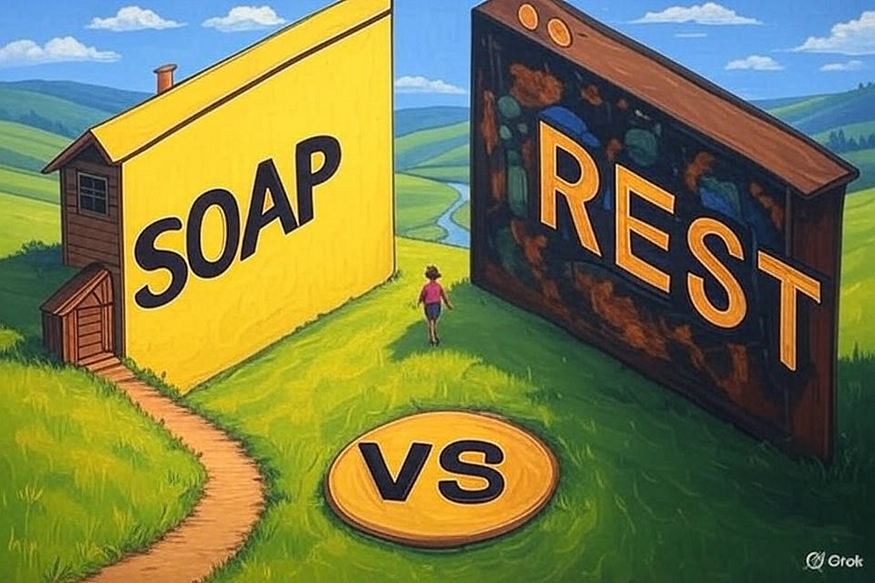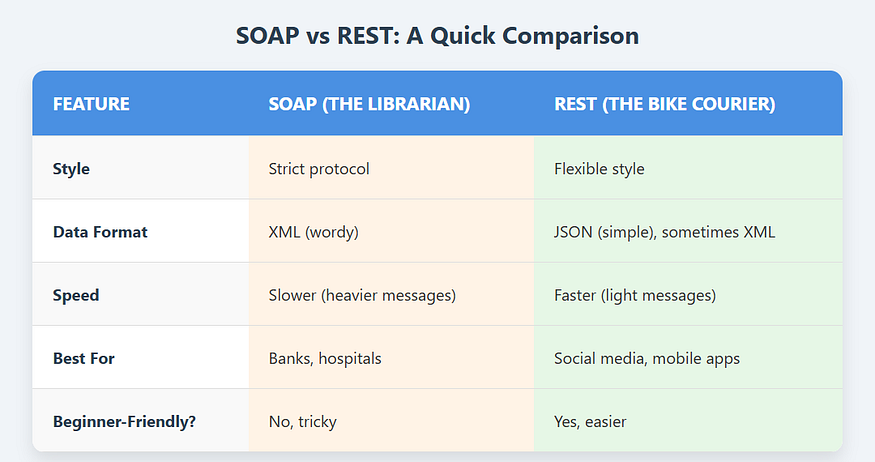“SOAP vs REST: A Battle of Web Service Titans”
 Asadul Islam
Asadul Islam
SOAP vs REST: A Beginner-Friendly Guide to APIs
Imagine you’re sending a package to a friend. You could use a formal courier service with strict rules and detailed paperwork, or you could ask a buddy to drop it off quickly. In the world of APIs — think of APIs as messengers that let apps talk to each other, like ordering food or checking the weather — SOAP and REST are two popular ways to send those messages. SOAP is like the formal courier, while REST is the laid-back buddy. Let’s break them down in a simple, beginner-friendly way to help you understand their differences and when to use them.
What Are SOAP and REST?
SOAP (Simple Object Access Protocol) is a strict set of rules for sending messages between apps. It’s like a librarian who follows a precise checklist to make sure everything is perfect. It uses XML (a structured but wordy format) and comes with built-in features for security and reliability.
REST (Representational State Transfer) is a flexible, lightweight style for building APIs. It’s like texting a friend to pick up and deliver your package — it’s quick, simple, and uses standard web tools like URLs and JSON (an easy-to-read data format).
Think of APIs as the middleman between apps. For example, when you check the weather on your phone, the app sends a request to a weather service’s API, which replies with the forecast. SOAP and REST are just different ways to handle that request and reply.
SOAP: The Formal Courier
SOAP is a protocol, meaning it has strict rules to ensure apps communicate reliably, even if they’re built on different systems (like one app in Java and another in Python). It’s designed for situations where mistakes aren’t an option, like transferring money or sharing medical records.
How SOAP Works
Structured Messages: SOAP uses XML, which is like filling out a detailed form for every message. Each message has a specific format with sections for the sender, receiver, and data.
Built-in Features: It includes tools for security (like encryption) and error handling (to catch mistakes), making it super reliable.
Example: Imagine a bank’s API for transferring money. SOAP ensures the transaction is secure, follows strict rules, and is delivered without errors — like a courier double-checking every detail.
Why Use SOAP?
Super Secure: Perfect for sensitive tasks like banking or healthcare.
Reliable: Guarantees messages are delivered correctly, no matter what.
Works Everywhere: Its strict rules make it compatible across different systems.
Why Not Always Use SOAP?
Complex: Setting it up can feel like learning a new language.
Slow: XML is bulky, so messages take longer to send.
Overkill for Simple Apps: It’s like using a armored truck to deliver a pizza.
REST: The Friendly Bike Courier
REST is an architectural style, meaning it’s more like a set of guidelines than strict rules. It’s designed to be fast, flexible, and easy to use, making it popular for modern apps like social media, mobile apps, and online shopping.
How REST Works
Simple Requests: REST uses URLs (like
website.com/users) and standard web commands (like GET to fetch data or POST to send data). It’s like texting a friend, “Hey, grab my package!”Lightweight Data: It usually uses JSON, which is compact and easy to read, though it can also use XML or plain text.
No Memory: REST treats each request as brand-new, so the server doesn’t need to remember past messages, keeping things light.
Example: When you check your Twitter feed, the app sends a REST request to Twitter’s API (like
api.twitter.com/tweets), and the API replies with the latest tweets in JSON.
Why Use REST?
Fast: Smaller messages mean quicker responses.
Easy to Learn: Its simplicity makes it beginner-friendly.
Scalable: Handles lots of users, perfect for apps like Instagram or Netflix.
Why Not Always Use REST?
Less Secure: Needs extra tools (like OAuth) for top-notch security.
Less Reliable: If a request fails, you might need to retry manually.
Inconsistent: Different REST APIs may work slightly differently, which can confuse beginners.
SOAP vs REST: A Quick Comparison

When to Choose SOAP vs REST
Choosing between SOAP and REST depends on your project’s needs. Here’s a beginner’s guide to deciding:
Choose SOAP if:
You’re building something super secure, like a banking or healthcare app.
You need guaranteed reliability, like ensuring a payment goes through.
You’re working with older systems that already use SOAP.
Choose REST if:
You’re building a modern app, like a social media platform or mobile game.
You want something fast and easy to set up.
You need to handle lots of users (like a popular shopping website).
For example:
A hospital’s patient record system might use SOAP to ensure data is secure and reliable.
A weather app might use REST to quickly fetch and display forecasts for millions of users.
Key Differences On how SOAP and REST works
Let’s dive a bit deeper into how SOAP and REST work differently, using simple terms:
What They Focus On
SOAP: Focuses on actions. It’s like telling a librarian, “Add this book” or “Delete that record.” For example, a SOAP API might have a function called AddUser to create a new user.
REST: Focuses on things. It’s like visiting a webpage called website.com/users and saying, “Show me all users” or “Add a new user.” It’s about working with data, not specific tasks.
How They Store Info
SOAP: Remembers past requests (like a friend who recalls every chat). This means the server tracks what’s happened before, which can be useful but requires more memory.
REST: Forgets everything after each request. Each message is independent, making it lighter and easier to scale.
Speed and Scalability
SOAP: Slower because XML messages are big and detailed. It’s also harder to scale since it needs more server power to remember past requests.
REST: Faster thanks to smaller JSON messages. It scales easily by passing requests to other servers, like a delivery service hiring more couriers.
Ease of Use
SOAP: Feels like filling out a long, formal document. It’s powerful but takes time to learn.
REST: Feels like sending a quick text. It’s intuitive, especially if you’re familiar with web URLs.
Tips for Beginners
Start with REST: If you’re new to APIs, REST is easier to learn and more common in modern apps. Try building a simple REST API to fetch data, like a list of movies or posts.
Explore SOAP Later: Once you’re comfortable with APIs, try SOAP if you’re curious about secure, enterprise-level systems.
Use Tools: Test REST APIs with tools like Postman (a free app for sending API requests). For SOAP, you might need a tool like SoapUI to handle XML messages.
Learn JSON: Since REST often uses JSON, understanding JSON is a great first step. It’s like learning the language of modern APIs.
Wrapping Up
SOAP and REST are two ways to build APIs, each with its own strengths. SOAP is like a formal, rule-following librarian — perfect for secure, reliable tasks but complex and slow. REST is like a fast, friendly bike courier — great for modern apps, easy to use, but needs extra care for security and reliability.
If you’re just starting out, REST is the way to go for most projects because it’s simpler and widely used. As you grow as a developer, you’ll appreciate SOAP for specific cases where security and reliability are critical.
Happy coding, and have fun building your first API!
Subscribe to my newsletter
Read articles from Asadul Islam directly inside your inbox. Subscribe to the newsletter, and don't miss out.
Written by

Asadul Islam
Asadul Islam
Software engineering enthusiast